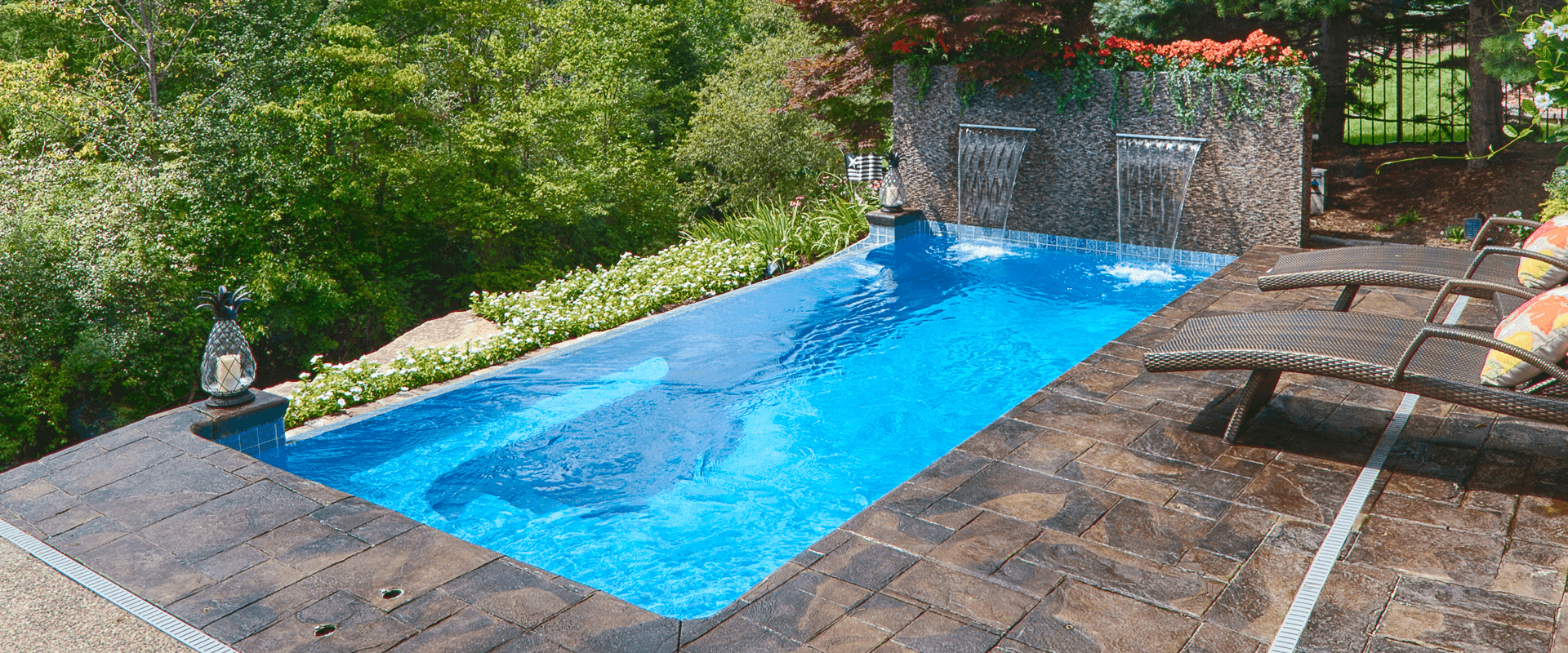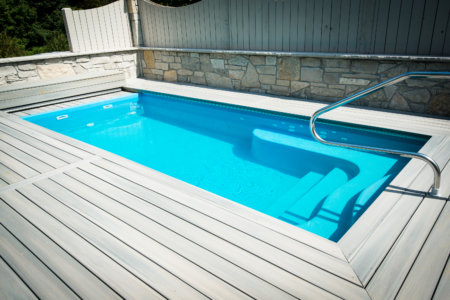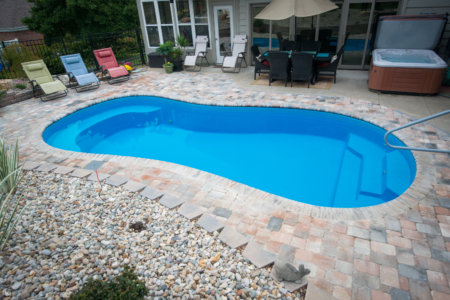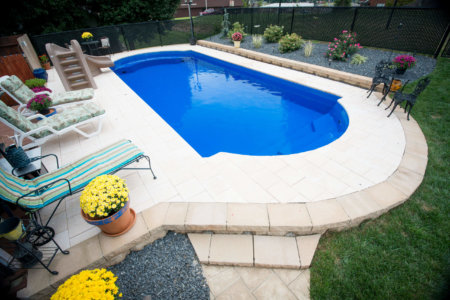877-929-(7665)
Inground pools, such as fiberglass pools, are on many homeowners’ bucket lists. However, not everyone has unlimited space to install a pool, leading to frequently asked questions such as, “What kind of pool do I need for a small backyard?” and “How much room do you need for a fiberglass pool?” The good news is that fiberglass pool sizes range from small to large, and small fiberglass pools will fit in almost any backyard.
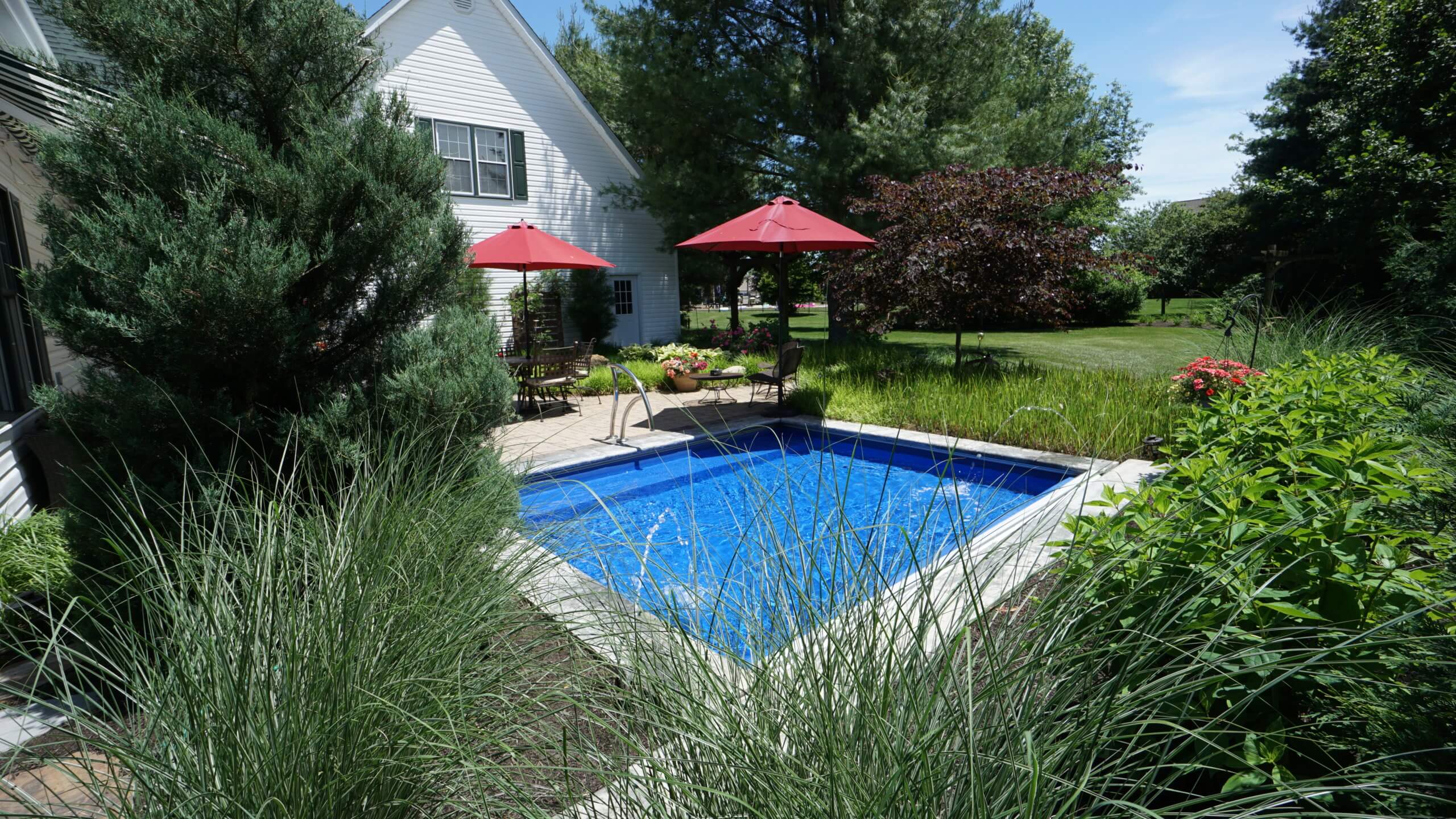
What are small inground pools called?
Small inground pools, those measuring fewer than 400 square feet, are called various names, including cocktail pools, plunge pools, and wading pools. Depending on how you want to use your pool, you may select one small pool design over another.
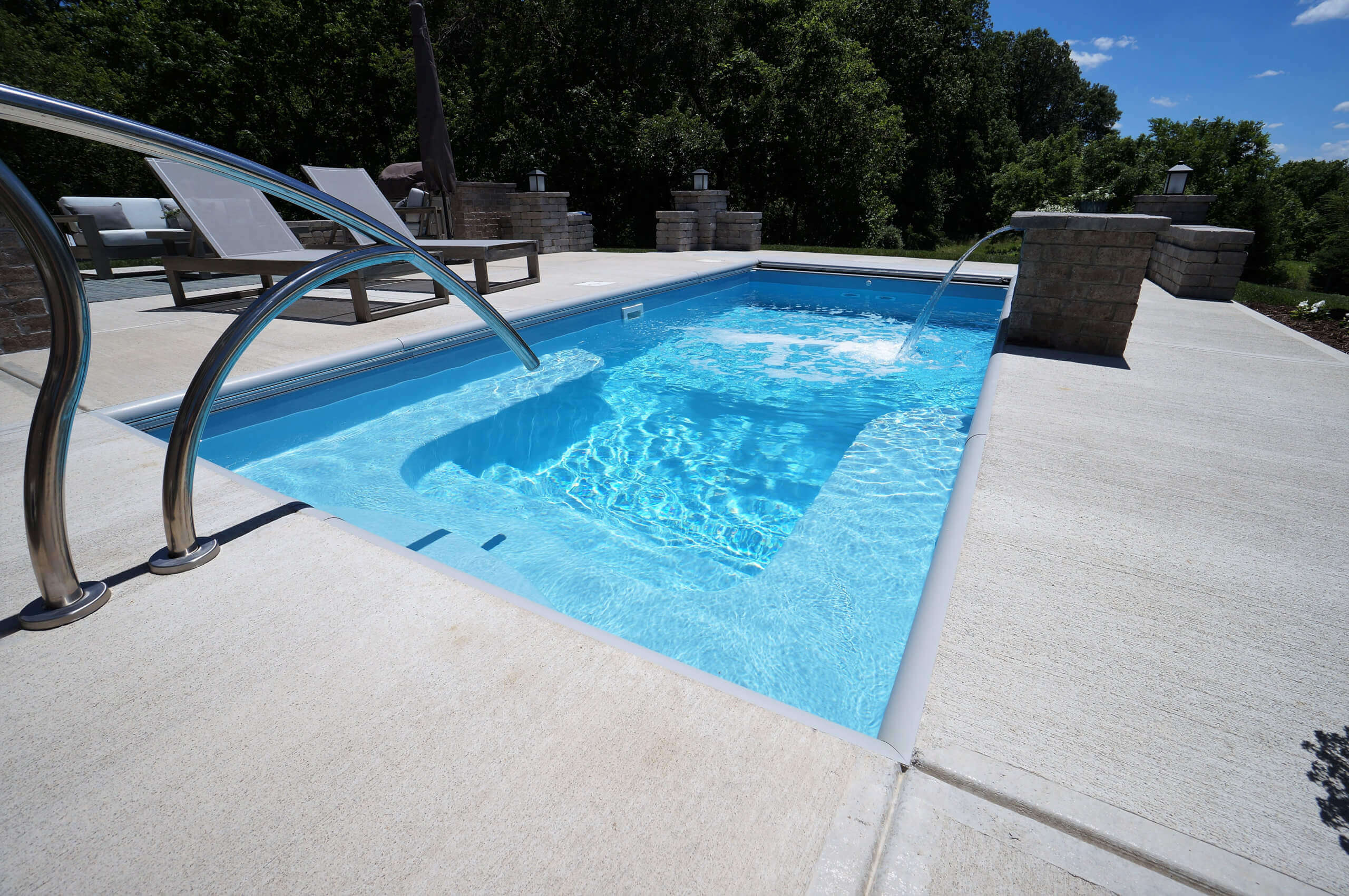
How much is the smallest fiberglass pool?
A good rule of thumb for inground fiberglass pool installation is $1,500 per linear foot. However, many factors go into pricing a fiberglass pool, from the add-on features to your soil type.
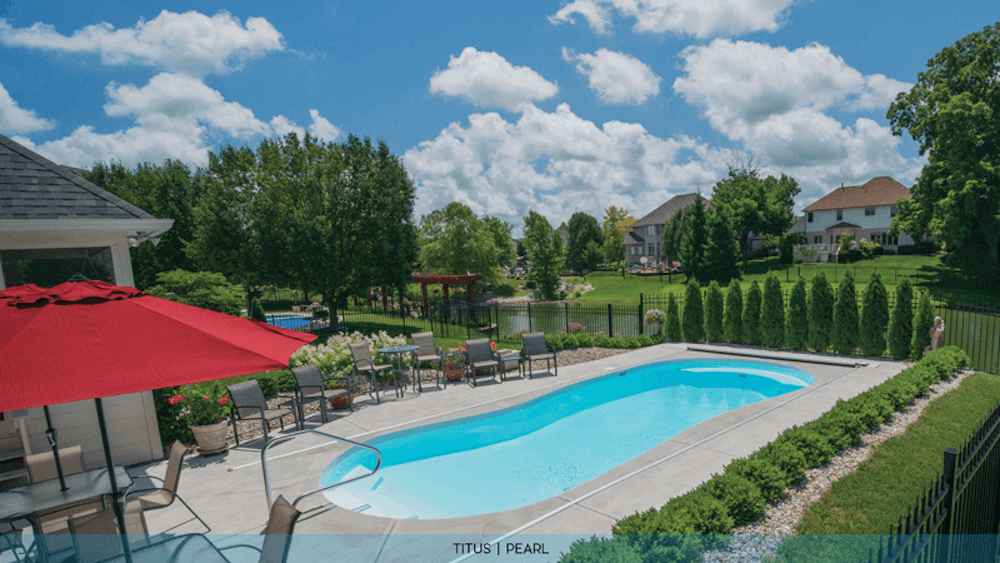
What is the smallest inground pool I can get?
With a custom build, there's no limit to how large or small your pool can be. We consider anything under 400 square feet a small pool in our fiberglass pool designs. (Keep in mind that fiberglass pools come in predetermined sizes and cannot be customized.)
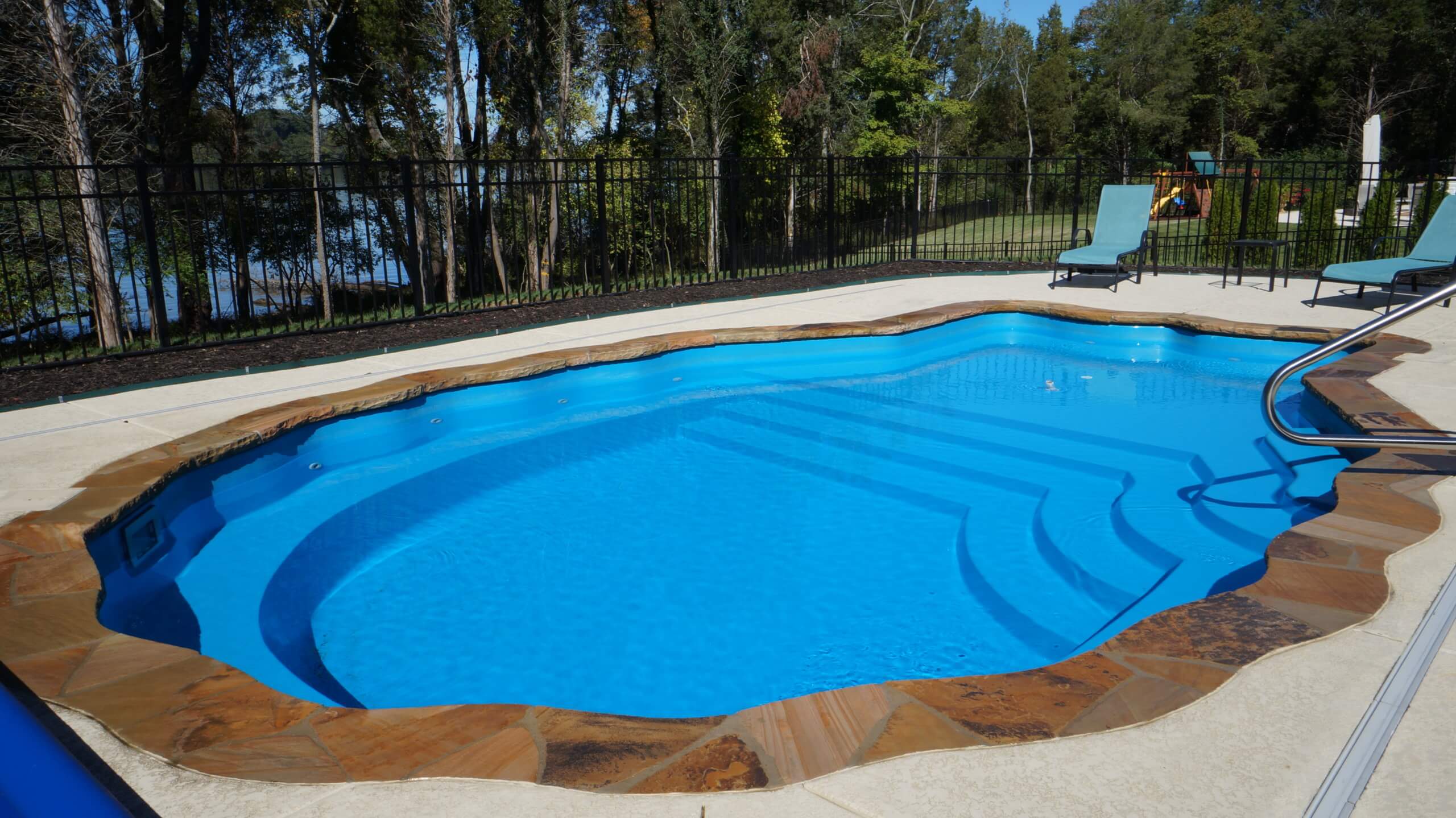
What’s the best pool shape for a small backyard?
Because every backyard is different, there is no singularly best shape for your pool. Before putting in a new pool, deciding how you want to use your small backyard and pool is essential. Then you can choose a pool form that fits your desired function.
What are small inground pools called?
Small inground pools, those measuring fewer than 400 square feet, are called a variety of different names. Some of the most common terms we’ve heard people use to describe small pools are:
- Spools
- Cocktail pools
- Plunge pools
- Wading pools
Each describes something slightly different, but all are often used interchangeably to describe a small pool, one that will fit in a small backyard. Depending on how you want to use your inground pool, you may be interested in the following questions.
What are shallow pools called?
Not meant for swimming, a wading pool is a type of shallow pool that is also typically on the smaller end. Wading pools make a beautiful backyard water feature for those who want to enjoy the aesthetic, wade, and sunbathe in cool waters. They also are great for small children who aren’t swimming yet. (Make sure to supervise children at all times in any water depth.) Thursday Pools offers a wading pool 9 feet by 9 feet and 18 inches deep.
Why is it called a cocktail pool?
A cocktail pool is another term for a small pool that measures under 400 square feet and is approximately four feet deep. While you could swim in some cocktail pools, they’re primarily used for entertaining. In fiberglass cocktail pools, you’ll find built-in and wrap-around benches that provide places to soak and socialize.
What is a plunge pool?
Also great for social gatherings, plunge pools are small pools similar to cocktail pools but are often deeper. The depth allows for low-impact exercise and playing games.
What is a spool?
You may have guessed that a spool is a combination spa and pool. You can get the best of both worlds by equipping your small pool with spa jets while saving space.
What is the smallest pool you can swim laps in?
Lap swimming is possible even with a small pool. Experts recommend a pool depth of at least 3’6″ so that you do not scrape your hands or legs while swimming. But as long as your pool is deep enough, you can turn it into a lap pool by installing a jet system.
How much is the smallest fiberglass pool?
Small fiberglass pools are typically less expensive than larger ones. Price tends to vary more based on size rather than shape/form.. You will also want to consider the on-site work that will go into your pool and what that may cost.
Fiberglass pools cut out a lot of on-site work. They are built in various shapes and sizes and come as a one-piece pool shell. While it may be tempting to try to save money by installing a fiberglass pool yourself, things can go wrong, and it can void your warranty. We’ve heard some horror stories about DIY pool installations that end up costing way more because they need fixing. We advise against the DIY installation of fiberglass pools, even small ones.
While you can use $1,500 per linear foot as a ballpark estimate for one of our fiberglass pools, there are other factors to consider. We’ll break down a few of these costs so you can get a better idea of how much it will cost to install a fiberglass pool.
What is the most expensive part of installing a pool?
The comprehensive costs of a pool installation may include factors such as:
- Permits and variances. Make sure to ask if your dealer will handle the necessary permits and variances and whether they are included in the basic installation costs.
- Fencing. Some jurisdictions require you to have fencing around your pool for safety and insurance compliance. The average cost to install a pool fence is $15 to $25 per linear foot. Your pool dealer will likely know the local requirements and may or may not install fencing.
- Pool cover. Pricing will likely differ depending on the material. Manual covers often use a track and reel system, and pricing will vary depending on whether it is made of safety material. Automatic safety covers are the most convenient, require an electrical hookup, and may cost a bit more. Check with your dealer to see what type of cover options are available.
- Electrical work. Electricity is essential for the operation of your filtering system, and it may also be needed for lights, jetting, or other decorative touches. Clarifying what electrical is included in your pool installation will help you better plan for this part of the process.
- Dirt hauling. Digging up enough yard to set a pool into it means you could be removing the equivalent of a one to a two-car garage full of dirt before dropping your fiberglass pool shell into place. A ballpark estimate for hauling away dirt is a couple of hundred dollars per cubic yard. Ask your dealer how much dirt hauling is included in your installation (if any).
- Equipment. Your installation will likely come with some equipment. Of course, you should ask your dealer and check your estimate to verify. Generally, your equipment will include the filtration system, skimmer and jets, a vacuum head and pole, vacuum hose, skim net, wall brush, thermometer, and chemical test strips. Your installation may have additional options, such as a pool heater, automatic vacuum system, and salt generator.
- Backfill. Most likely, your installation includes some type of backfill. If it’s not a line item on your estimate, ask your dealer if it’s included. Backfill is the material that supports your fiberglass pool walls as it is set into place.
- Restoration. Some pool installs are more complex than others based on space, access, and even the materials needing removal. Pool installation can bring a combination of trucks, jackhammers, and other heavy equipment to your backyard. When it’s all done, and your pool is ready for use, landscaping or hardscaping work may be needed to ensure the surrounding environment does your beautiful new pool justice. Ask your dealer what is included in your installation.
What is the smallest inground pool I can get?
When considering how small of a pool to get for your backyard, start by designating 25 percent or less of your yard space for your pool. The average size of an American backyard is about 6,000 square feet. However, depending on your location, average backyards can be considerably bigger or smaller. For example, the average backyard in Vermont is over 70,000 square feet. But in California, where land prices are some of the most expensive in the country, an average yard size can be around 1,625 square feet. You can likely fit a small pool in a 1200-square-foot yard and still have room for some patio space.
Standard sizes for fiberglass pools are 600 square feet or more for large pools, 400 to 600 square feet for medium pools, and 400 square feet or fewer for small fiberglass pools. Thursday Pools small pool designs include:
| Thursday Pools Pool Design | Dimensions | Square Feet |
| Wading Pool 1 | 9′ x 9′ 1’6″ | 81 ft2 |
| Wet Deck | 14′ x 8′ 1′ | 112 ft2 |
| Pearl | 15′ x 25′ 3’9″ | 375 ft2 |
| Sea Turtle | 9.5′ x 19.5′ 4’6″ | 185.25 ft2 |
| Aspen (also comes in four larger sizes) | 12′ x 25′ 5’1″ | 300 ft2 |
| Titus | 12′ x 26′ 5’5″ | 312 ft2 |
| Cathedral | 14′ x 33′ 5′ | 462 ft2 |
| Lil Bob | 13.5′ x 27.5′ 4’6″ | 371.25 ft2 |
Best pool shape for small backyard
Aside from the shape and layout of your backyard, other factors to consider are access, and which parts of your yard get sunshine. If you have natural or manufactured elements that already exist, you might choose to avoid them or incorporate them into your design. That said, let’s look at a few of the different shapes of small fiberglass pools and see how they work in more compact backyards.
Rectangular Pool Shapes
Small fiberglass pools in a rectangular shape are an effective way to use limited space. This shape can fit easily into backyard corners. Tuck it in along the house or fence line to align with perimeters. And if you are looking for more outdoor living space, build a multi-level patio and put your pool on either the lower terrace or the upper one.
Freeform Pool Shapes
Freeform pools mimic nature, providing a natural flow for landscaping. And the curves allow lounge chairs to sit back away from your pool while still giving swimmers enough room to get in and out of the pool.
Roman-Style Pool Shapes
Roman-style pools have a distinct luxurious aesthetic and combine the straight lines of a rectangular pool with the curves of a freeform. The shape allows for open swim space and ample seating areas on the ends.
